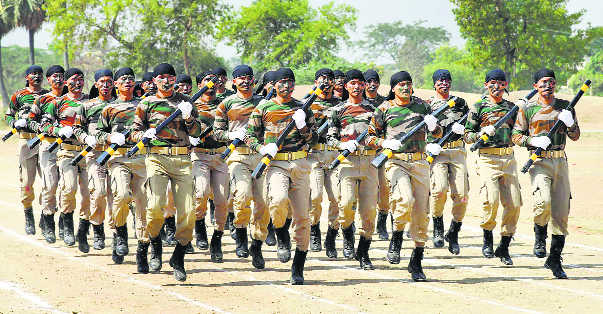
Military reforms: DPC is hailed as a milestone. PTI
Bhartendu Kumar Singh
Indian Defence Accounts Service
When the Defence Planning Committee (DPC) was announced recently, it was hailed as another milestone in India's ongoing military reforms. Expectations are naturally up that the DPC would carve out grand narratives for facilitating India's quest for military power. While many components of India's rising military power profile have been discussed and debated in the follow-up period, the financial aspects remain overlooked. Unless the financial atmospherics are properly delineated, the true roadmap for various components of defence planning may not emerge.
Mainstream literature on defence as well as recent write-ups on DPC treat defence planning as essentially a military issue. This is, perhaps, not true. Apart from matters of war and peace, defence planning is equally about economics since the entire fulcrum of military issues are shaped by economic factors. Kevin Narizny in his book ‘The Political Economy of Grand Strategy’ hypothesises that economic interests determine great power military strategies. The very first dimension of modern-day grand strategy is a state's assertiveness or its willingness to pay the costs (military spending, diplomatic capital etc). His emphasis on politico-economical approach remains the best tool to understand the rise of economic powers (like the UK and US). Therefore, the utilitarian aspect of the DPC lies in enabling India’s military modernisation and reforms in a systematic way along with and benefiting from the country's growing economic profile.
The institutional arrangement for a revamped DPC is necessitated partly because past efforts for autonomous and independent defence planning did not yield the desired results. To ensure flexibility, the defence sector was kept out of the purview of the erstwhile Planning Commission and treated as a 'non-Plan' expenditure. However, that arrangement did not work, best evident in delayed approvals of defence five-year plans and associated funding problems. Indian defence planning was often a victim of segregated approach in the last 70 years, having no correlation with the other important aspects of the nation-building process. The low levels of economic growth often translated into scarcity of resources for the defence sector. Further, the macro-reforms of the early 90s did not touch the defence sector.
From a futuristic perspective, India as a rising military power is still exploring a cost-effective trajectory on many issues. The revamping of the Planning Commission into Niti Aayog offers an opportunity for a synchronised thinking on defence and development where both supplement each other, ie development as the best form of defence and defence contributing to the developmental aspects like growth of a robust military industrial complex.
The DPC has a challenging objective of ensuring a cost-effective approach to India's rise in global politics. At the minimum, India needs a peaceful environment that is conducive to its goals without being overtly distracted by conflictual relations with China and Pakistan. This is possible by a deft crafting of a national security strategy (NSS), one of the key mandates for the DPC. We need to take a cue from the US NSS, wherein equal emphasis has been given on economic aspects of security and a series of white papers on defence by China over the years that sought to create a ‘peaceful periphery policy’ for enabling focussed attention on development.
There are many financial issues that need consideration of the DPC.
1 First, despite the healthy growth in revenue expenditure and budgetary allotment for the same for defence, statements have poured in media lamenting the slow growth of revenue expenditure and its adverse impact on the modernisation plans of the armed forces. In fact, even after adjusting for inflation, there has been a net increase in the defence expenditure by 0.75 per cent in 2018-19 over the previous year. However, the DPC would be challenged in taming the galloping revenue expenditure by innovative ways to facilitate equal consideration for other priority sectors like health, education and infrastructure.
2 Second, there is need to build up a defence posture on the basis of internal strength and save money wherever possible. For example, India has established a lead in missile defence largely through indigenous research and development. And yet, as Stephen Cohen, noted South Asia expert, laments, there has been no systematic analysis of trade-offs between aircraft and missiles. No country chooses one exclusively over the other, but according to him, understanding the trade-off is important to balance investment. It would be prudent to add that such trade-offs be exercised on a larger scale in mapping out various components of defence planning.
3 Third, contemporary wars are waged by 'other means'. Focus has shifted to preferred tools like 'geo-economics'. The Trump administration is practising it vigorously with even allies falling prey to sanctions and duty regime. China is another good player in geo-economics, as is evident in its mega initiative of Belt and Road Initiative and trapping most South Asian countries into its fold. Economic power is as important as military power and increasing India’s visibility in the international economic order, therefore, deserves more salience in DPC's thought process.
These are just representative examples. The idea is to reiterate that while financial aspects are only a part of the larger defence planning problem, the bottomline apprehension is that if they remain neglected or overlooked, we may find it difficult to secure a cost-effective defence planning for India.
(Views are personal)



























